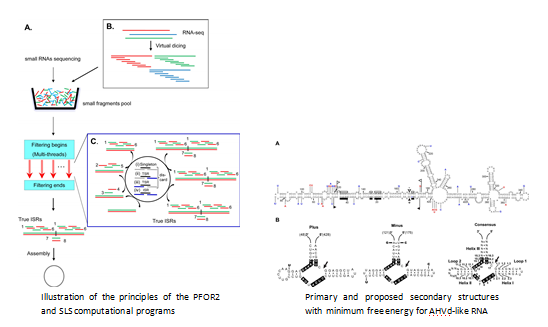Discovery of Replicating Circular RNAs by RNA-Seq and Computational Algorithms
Recently, a cooperation between Institute of Plant Protection, Chinese Academy of Agricultural Sciences (CAAS) and School of Life Sciences, University of Science and Technology of China has yielded a big progress in the field of circular RNA (circRNA). Researchers discovered two novel replicating circRNAs from grapevine and apples plants using the further improved computational algorithm which was developed by themselves. The research results have been published online in PLoS Pathogens on December 11, 2014.
RNA, a basic biomacromolecule, not only is able to carry and transmit genetic information, but also plays critical roles in regulation of gene expression. In addition to the classic RNAs of tRNA, mRNA, and rRNA, cells contain a striking diversity of additional RNA types including miRNAs, siRNAs, piRNAs, lncRNAs and other noncoding RNAs (ncRNA). They accomplish a remarkable variety of biological functions, regulating gene expression at the levels of transcription, RNA processing, and translation. “The versatility of RNA functions seem limitless. The latest surprise comes from circular RNAs” (Kosik, K. S., Nature, 2013, 495: 322-324). Thousands of non-replicating circRNAs have been identified in various organisms. Interestingly, a few circRNAs have been shown to play regulatory roles. However, the functions of circRNAs are largely remain unknown. Viroids have been proven to be excellent biological models for studying ncRNAs and circRNAs. But the rate of discovery of the replicating circular RNAs-viroids is still very low.
In this study, a considerably improved computational algorithms was developed by adopting parallel programming in the C++ language. The use of the new algorithms led to the discovery of a new viroid from grapevine and a viroid-like circular RNA from apple trees. Moreover, a new program was developed for the discovery of distinct classes of circular RNAs, including those neither replicate nor induce in vivo accumulation of Dicer-dependent siRNAs. The application of the new algorithms would speed up the discovery of novel circular RNAs and expand the list of known host species that can be infected by viroids.

More details are available on the bellow links:
http://www.plospathogens.org/article/info:doi/10.1371/journal.ppat.1004553
By Shifang Li
sfli@ippcaas.cn
-
 China-Laos Training Workshop on Integrated Management of Destructive Crop Pests and Diseases Successfully held in Laos
China-Laos Training Workshop on Integrated Management of Destructive Crop Pests and Diseases Successfully held in Laos -
 New Plant Protection: New challenge and new opportunity for plant protection
New Plant Protection: New challenge and new opportunity for plant protection -
 International and SELAMAT Conference on Pesticide Residue and Mycotoxin Contamination Held in Beijing
International and SELAMAT Conference on Pesticide Residue and Mycotoxin Contamination Held in Beijing -
 CAAS President Meets Chairman of ASEAN FAW Taskforce
CAAS President Meets Chairman of ASEAN FAW Taskforce
